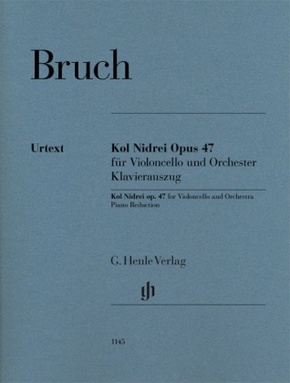Max Bruch - Kol Nidrei op. 47 für Violoncello und Orchester - Besetzung: Violoncello und Klavier. 235 Min.
| Verlag | Henle |
| Auflage | 2019 |
| Seiten | 14 |
| Format | 23,5 x 31,0 x 0,4 cm |
| Gewicht | 105 g |
| Reihe | G. Henle Urtext-Ausgabe |
| ISBN-13 | 9790201811451 |
| Bestell-Nr | 79016211BA |
_mit bezeichneter und unbezeichneter Streicherstimme
Max Bruchs "Kol Nidrei" gehört - neben dem populären 1. Violinkonzert - zu seinen berühmtesten Kompositionen. Das wehmütige "Adagio nach hebräischen Melodien" entstand 1880 für den Cellisten Robert Hausmann. Es verarbeitet zwei alte jüdische Gesänge, deren außerordentliche Schönheit den Protestanten Bruch nach eigener Aussage tief bewegte. Der tenorale Celloklang ist das ideale Medium für die Stimme eines jüdischen Kantors, und so liefert "Kol Nidrei" bis heute jedem Cellisten eine wunderbare Vorlage für das "Singen" auf dem Instrument. Mit dieser auf der Erstausgabe von 1881 basierenden Edition erscheint "Kol Nidrei" erstmals in einer wissenschaftlich fundierten Urtextausgabe, wofür neben den musikalischen Quellen auch zahlreiche Briefe und Dokumente aus dem Max-Bruch-Archiv herangezogen wurden. Für die Bezeichnung der Solostimme konnte Christian Poltéra gewonnen werden.
Mehr zu dieser Ausgabe im Henle-Blog.
Inhaltsverzeichnis:
Kol Nidrei op. 47
_with marked and unmarked string part
Aside from his popular Violin Concerto no. 1, "Kol Nidrei" numbers among Max Bruch's most famous compositions. The melancholy "Adagio after Hebrew melodies" was written in 1880 for the cellist Robert Hausmann. It treats two old Jewish songs whose extraordinary beauty proved deeply moving to the Protestant Bruch, by his own admission. The tenor cello sound is the ideal medium for the voice of a Jewish cantor, and thus to this day "Kol Nidrei" offers every cellist a wonderful opportunity to make the instrument "sing". In this text, based on the first edition of 1881, "Kol Nidrei" appears for the first time in an Urtext edition substantiated by scholarly research, for which not just the musical sources, but also numerous letters and documents from the Max Bruch Archive were consulted. Christian Poltéra was able to be procured for the markings in the solo part.
Read more about this edition in the Henle Blog.

